notPlanned
Type of resources
Available actions
Topics
Keywords
Contact for the resource
Provided by
Years
Formats
Representation types
Update frequencies
status
Scale 1:
Resolution
-
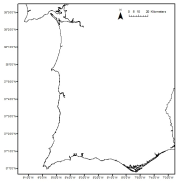
Cymodocea nodosa meadows distribution in the south of Portugal from historical data. Data provided by the Life Project BIOMARES and published in: ÔÇ£Seagrasses in Portugal: A most endangered marine habitatÔÇØ. Aquatic Botany. doi:10.1016/j.aquabot.2011.08.007. ÔÇ£Estimation of available seagrass meadows area in Portugal for transplanting purposes ÔÇØ. Journal of Coastal Research (2009) :SI 56 (1100-1104)
-
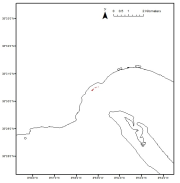
Zostera noltii meadows distribution in the Portuguese mainland from historical data. Data provided by the Life Project BIOMARES and published in: ÔÇ£Seagrasses in Portugal: A most endangered marine habitatÔÇØ. Aquatic Botany. doi:10.1016/j.aquabot.2011.08.007. ÔÇ£Estimation of available seagrass meadows area in Portugal for transplanting purposes ÔÇØ. Journal of Coastal Research (2009) :SI 56 (1100-1104)
-

Maerl beds distribution in the Portuguese mainland from historical data. Data published in: ÔÇ£Present distribution of maerl beds in the Atlantic Iberian PeninsulaÔÇØ. Museologia Scientifica e Naturalista. Volume Speciale 2009
-
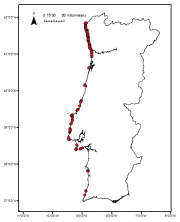
Saccorhiza polyschides distribution in the Portuguese mainland from historical data. Data provided by the Project FindKelp and published in: ÔÇ£Findkelp, a GIS-based Community Participation Project to Assess Portuguese Kelp Conservation StatusÔÇØ. Journal of Coastal Research (2009) :SI 56 (1469-1473)
-
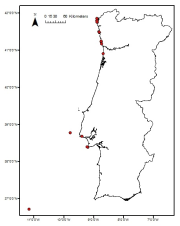
Laminaria ochroleuca distribution in the Portuguese mainland from historical data. Data provided by the Project FindKelp and published in: ÔÇ£Findkelp, a GIS-based Community Participation Project to Assess Portuguese Kelp Conservation StatusÔÇØ. Journal of Coastal Research (2009) :SI 56 (1469-1473)
-
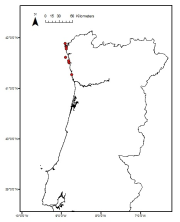
Laminaria hyperborea distribution in the Portuguese mainland from historical data. Data provided by the Project FindKelp and published in: ÔÇ£Findkelp, a GIS-based Community Participation Project to Assess Portuguese Kelp Conservation StatusÔÇØ. Journal of Coastal Research (2009) :SI 56 (1469-1473)
-
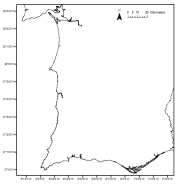
Zostera marina meadows distribution in the Portuguese mainland from historical data. Data provided by the Life Project BIOMARES and published in: ÔÇ£Seagrasses in Portugal: A most endangered marine habitatÔÇØ. Aquatic Botany. doi:10.1016/j.aquabot.2011.08.007. ÔÇ£Estimation of available seagrass meadows area in Portugal for transplanting purposes ÔÇØ. Journal of Coastal Research (2009) :SI 56 (1100-1104)
-
Data were collected in the framework for the stablishment of the Capo Milazzo AMP. The study was founded by MATTM. The map was constructed by using acustic data, direct observations by ROV and satellite images.
-
The project had the aim to map intertidal and subtidal habitats at the Sore Sunnmore area on the West coast of Norway. We collected data points in the intertidal and in the seaweed, kelp and red algae bed in the subtidal. These data were used to model the distribution of different habitats. Habitat data was analysed (using the R package mlogit for Multinomial Logit Models, CRAN - Package mlogit (r-project.org)) against modelled depth, seabed light, salinity, temperature and wave exposure. 30 habitats were modelled, which again was transformed into composite maps, identifying the most dominant habitat/species.
-
The aim of the National Program for Mapping Biodiversity – Coast is to provide Norwegian managers and planners with maps of the distribution of marine habitats and key areas for species. Carbonate sand is composed of skeletal fragments from marine organisms, mostly shells, snails, barnacles, sea urchins and calcareous algae, accumulating during the past 10 000 years. Carbonate sand deposits with ongoing production and accumulation were identified through distribution modelling (using statistical methods such as GAM, BRT, Maxent) based on presence–absence data of carbonate sand deposits from grab samples (collected by the Geological Survey of Norway). Depth, wave exposure and ocean current speed were the most important predictors. Polygon areas were derived from the model according to the routine established in the Norwegian National Program for Mapping Biodiversity – Coast.
 EMODnet Product Catalogue
EMODnet Product Catalogue